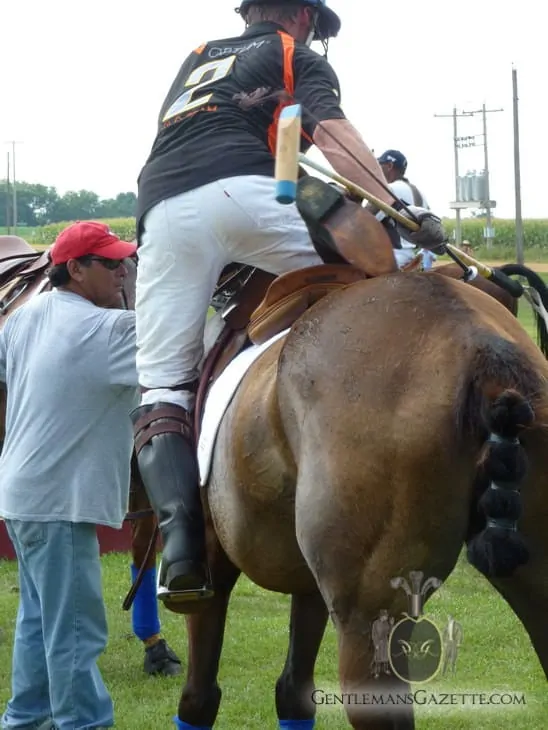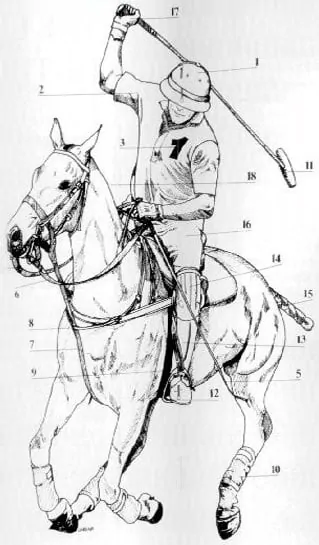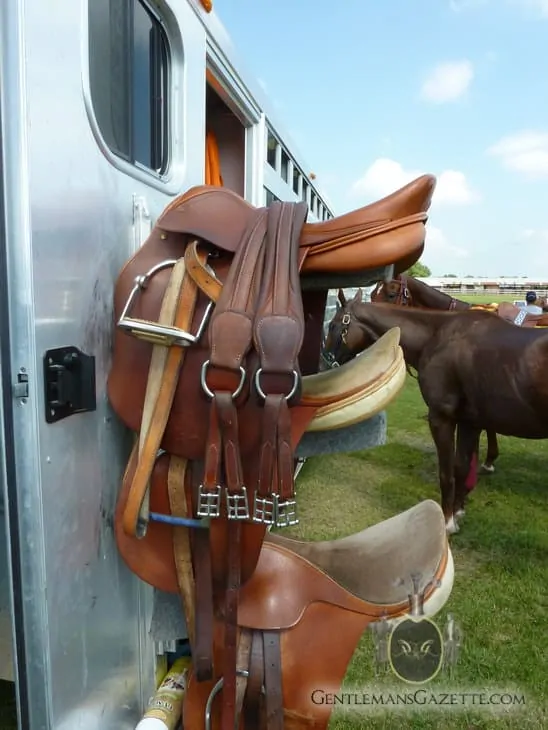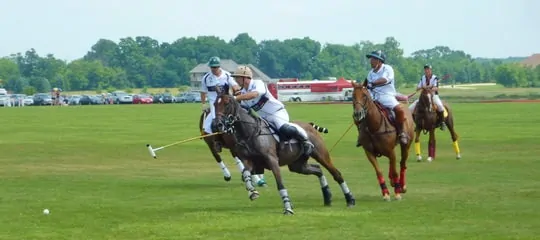This weekend, I visited the Twin Cities Polo Classic, an annual Polo tournament that is a fundraiser for the University of Minnesota Equine Center. With temperatures at about 95 °F, it was a feat of stamina for the attendees and the few dozen horses to attend the event. During a long break, I had a chance to talk to a number of players who told me quite a bit about polo itself, the horses and the equipment. Hence, we will talk about the game of polo today, and in the next couple of days, we will follow up with an article about the tournament itself.
The Basic Rules of Polo
Usually, a polo match is divided into 4 to 6 periods called chukkers. Each of these is 7.5 minutes long and at 7 minutes you will hear a warning bell before the final bell rings once more at the end of each chukker. However, if a team scores after the 7 minutes warning bell, or if the ball touches the sideboards of the polo field, the chukker ends immediately. Since a chukker is rather tiring for the horses, the players have 4 minutes between the chukkers to switch horses. On a very hot day, some players may even change their horses during active play.
The Polo Players & Handicaps
Each outdoor polo team consists of four players numbered 1, 2, 3 and 4. Conversely, arena polo is only played with 3 players per team, but in this article we will focus on outdoor polo exclusively. No. 1 is generally the offensive player while No. 4 plays defense. Players No. 2 and 3 are often the most experienced players. No. 3 is usually the field captain who delegates the ball, and No. 2 is supposed push the play in the offense as well as the defense. None of them act as a permanent goal keeper. With only 4 players per team, each player should cover their numerical opponent on the polo field. Moreso than in many other sports, many players only reach their peak after years of competitive play.
Polo Handicaps
Sir Winston Churchill once stated: “A polo handicap is your passport to the world.” Considering that polo is played all around the globe and it is not uncommon for top players to travel with their horses to different countries, he was certainly right. The polo handicap was invented by Henry Lloyd Herbert, the first president of the US Polo Association, in 1890. The idea behind this rating system was to match teams more evenly when pairing players of varying skill levels. A player’s handicap is determined by a number of factors like sportsmanship, team play, scoring, knowledge of polo, strategy and horsemanship. Players are rated from minus 2, representing the most novice player, to 10, representing the best player. While about two thirds of all ranked players worldwide have a handicap of 2 or below, only about a dozen players are ranked with a handicap of ten. A handicap of 5 is usually only achieved by professional players. Moreover, the ranking in Argentina – the nation that has repeatedly produced many of the world’s best polo players – can be slightly different than rankings in the US, for example. In any case, each team’s handicap is the sum of the individuals’ handicaps; a team composed of 4 players with a handicap of 2 each would have a team handicap of 8, also referred to as an 8-goal team. In a handicap tournament, points are given to the lower rated team before the game even starts based on the difference of handicaps between the two teams. Let’s say the team with the 8-goal team plays a team with a 10-goal team, then the 8-goal team will get a 2 point head start. However, open tournaments, where teams play “on the flat,” indicating that the handicap of the teams do not matter with regard to scoring, each game starts at 0-0.
The Polo Field

In the US, a polo field is usually 200 yards wide by 300 yards long and the goals are 8 yards wide. In order to score a point, a player must hit the plastic ball between the goal posts – it does not matter how high or low the ball is. Interestingly, after each goal, the game is resumed from the middle, but the teams switch directions and aim for the opposite goal. To ensure fair play, two mounted referees – so-called umpires – are on the field as well, and a “third man” is located near the middle of the polo field to make decisions in case an umpire made a questionable call. Once a foul occurs, the umpire blows the whistle, which stops the clock. There are several lines on the field indicating where midfield, 60, 40 and 30 yard penalties are taken from.
Polo Ponies
The horses are traditionally called ponies. Most of the time, they come from the race track and have to be trained subsequently to perform in a polo game. Many of the polo ponies are faster on short distances than race horses! Apart from that, polo ponies must be very agile and they are naturally the most essential part of the polo game.

Polo Equipment
Besides the players and the horses, there is a number of gear that you will see at a polo match.
- HELMET internally padded and sometimes with a face guard
- SHIRT Polo Shirt
- NUMBER
- REINS for better control of the pony
- WHIP
- BIT Control of pony
- MARTINGALE Prevents the pony from raising its head too high and hence protects the polo player
- BREASTPLATE keeps saddle in place
- GIRTH keeps the saddle and the polo player in the correct position
- BANDAGES to protect the pony’s legs
- MALLET measures 48 to 54 inches in length; depends on pony height and reach of the player. Commonly made of bamboo and sometimes ashwood or maple. Ideally the ball is hit in the middle of the wide part
- STIRRUP for the players feet
- BOOTS brown or black almost knee high, with raised heels and often a zipper in the middle
- KNEE GUARDS
- PONY’S TAIL must always be braided
- BREECHES strictly white – often times players just wear white jeans
- GLOVES improves grip and protects hands
- MANE shaved or roached to alleviate interference
Fouls
Generally, it is not very easy to spot a foul. Even for professional polo players, it can be very difficult to determine whether a foul has been committed or not. Although there is a 53 page polo rule book in the US, I will try to share it in a nutshell. Basically, a foul occurs if there is dangerous play. The play is dangerous when a player crosses in front of the player with the ball. Hence, you should think about it this way: when the polo ball is hit, it creates an imaginary line and the polo players have to follow it. With each hit, the direction of the ball changes and so does the imaginary line. As a consequence of a foul, a penalty shot is awarded depending on where the foul was committed, or how severe it was. If the ball is hit past the back line by a defending player, a sixty-yard shot facing the spot where the ball went across the line is awarded.

The Divot Stomp – A Polo Tradition
The Divot Stomp is probably the most widely recognized tradition associated with polo. During half-time, spectators are invited to go onto the field in order to both socialize and stomp the divots which were created during the game by the horses’ hooves. Now that you know the basics of Polo, we can continue with our impressions of the Twin Cities Classics Polo Tournament next time. If you are now interested in becoming a polo spectator or maybe even at a polo player, just go to the website of the United States Polo Association and look for the nearest club. Outside the US, most countries do have a national polo association, which will most likely be able to direct you to a club in your area.

This was really great for a casual polo watcher myself.
Dear Joy, thanks for your comment. You have some nice photos on your blog by the way!